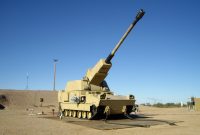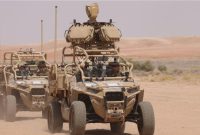The Bradley Armored Fighting Vehicle (Bradley AFV) has long been an iconic piece of the U.S. military’s arsenal. Introduced in 1981, the Bradley AFV has served in numerous conflicts, including the Gulf War, the War in Afghanistan, and the Iraq War. However, in recent years, it has become evident that the Bradley AFV was lagging behind modern infantry fighting vehicles from other nations. To meet the requirements of modern warfare, the U.S. military is in the process of developing a new infantry fighting vehicle known as the Objective Force Maneuver Vehicle (OMFV).

The OMFV is designed to replace the Bradley AFV. It boasts a more compact size, allowing it to operate effectively in urban environments. The OMFV is also equipped with a hybrid propulsion system, enhancing its mobility and fuel efficiency.

One of the standout features of the OMFV is its 30mm weapon system. This weapon system has the capability to engage and destroy light and medium armored targets. In addition to its primary armament, the OMFV is equipped with supplementary weaponry, including machine guns and anti-tank missiles.

The OMFV is expected to enter service by 2030, signifying a significant leap forward for the U.S. military. It will provide them with a modern and efficient infantry fighting vehicle that is better suited to meet the demands of contemporary warfare.

Body:
The Evolution of the Bradley AFV:
The Bradley AFV has a storied history within the U.S. military, serving as the primary infantry fighting vehicle for several decades. With its introduction in the early 1980s, it brought a combination of troop transport, firepower, and protection to the battlefield. It was designed to ensure the safe transport of infantry troops while providing the necessary firepower to support them in combat.
However, as warfare and technology evolved, the Bradley AFV began to show signs of obsolescence. It faced limitations in terms of size, mobility, and armament compared to contemporary infantry fighting vehicles. These limitations raised the need for a successor that could address the challenges of modern warfare.
Introducing the OMFV:
The Objective Force Maneuver Vehicle, or OMFV, was conceived as a replacement for the Bradley AFV. It is designed to be a highly adaptable, more compact, and agile infantry fighting vehicle, tailored for the changing dynamics of urban warfare and other complex environments.
Compact and Agile Design: OMFV features a more compact design that enhances its maneuverability in tight urban spaces. This design addresses the limitations of the Bradley AFV, which was better suited for more open terrain.
Hybrid Propulsion System: One of the significant innovations in OMFV is its hybrid propulsion system. This system combines traditional internal combustion engines with electric power. It not only offers enhanced fuel efficiency but also provides improved mobility and speed. The ability to operate silently with electric power is a valuable asset in modern combat environments.
Advanced Armament: The OMFV is equipped with a formidable 30mm weapon system. This armament provides the capability to engage a wide range of targets, from light armored vehicles to infantry. Additionally, it is fitted with secondary weapons like machine guns and anti-tank missiles, enabling it to tackle diverse threats effectively.
Future Deployment:
The OMFV program is anticipated to reach operational status by 2030. This marks a pivotal moment for the U.S. military as it transitions to a more advanced and versatile infantry fighting vehicle. The OMFV will serve as a key asset for the U.S. Army, ensuring its ability to meet the challenges of modern warfare head-on.
Conclusion:
The replacement of the Bradley AFV with the OMFV is a significant development in the evolution of infantry fighting vehicles for the U.S. military. The OMFV represents a vital step forward in addressing the shortcomings of its predecessor. With its compact and agile design, hybrid propulsion system, and advanced armament, the OMFV is poised to become a modern and efficient infantry fighting vehicle, offering improved mobility and combat capabilities. Its expected deployment in 2030 will contribute to the U.S. military’s readiness and adaptability in contemporary conflict scenarios.
Explanation of the Title:
The title, “Bradley AFV Replacement with OMFV Hybrid 30mm: A New Step for the U.S. Military,” was chosen to emphasize the significance of the OMFV program as a forward step for the U.S. military. It underscores the transition from the aging Bradley AFV to the modern OMFV, highlighting key features such as the hybrid propulsion system and the powerful 30mm armament. The title is designed to pique the reader’s interest and convey the idea of progress and advancement in military technology.
This article has provided essential information on:
The evolution of the Bradley AFV and its limitations in modern warfare. The introduction of the OMFV as a successor to the Bradley AFV. The OMFV’s compact design, hybrid propulsion system, and advanced armament. The anticipated deployment of the OMFV in 2030, signifying a significant development for the U.S. military.




